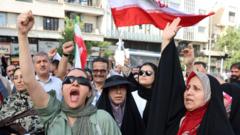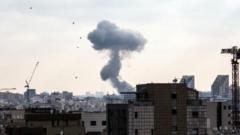In an unprecedented turn of events, Israelis woke up to a transformed landscape on June 22, 2025, after the U.S. military conducted extensive pre-dawn strikes on several key Iranian nuclear facilities. The situation has stirred a blend of optimism and anxiety among the populace, reflecting a spectrum of perspectives on what this escalated conflict might yield.
New Dynamics in the Israel-Iran Conflict Amid U.S. Military Intervention

New Dynamics in the Israel-Iran Conflict Amid U.S. Military Intervention
Israelis face mixed emotions following the U.S. strikes on Iran, evaluating the ramifications of this new phase in the conflict.
On one side of the spectrum, some Israelis expressed jubilation. They perceived the military action as a potential catalyst for a new era free from the looming threat of an Iranian nuclear program. These individuals believed that American involvement would alter the strategic balance in the region, possibly inaugurating a period of enhanced security and tranquility.
Contrastingly, a significant portion of the population harbored apprehensions regarding the prospect of increased Iranian retaliation. There were fears that the U.S. strikes could spark a broader, more protracted conflict, exacerbating the already fragile situation. This trepidation was palpable among families and individuals huddled in bomb shelters, their safety concerns amplified by the ongoing exchanges of fire between Israeli forces and Iran.
By early morning, following the U.S. strikes, Iran retaliated with missile barrages that sent millions of Israelis scrambling for safety. Yet, amid the palpable tension, some figures emerged in a spirit of resolve. Opposition leader Yair Lapid characterized the unfolding situation as “historic,” acknowledging the uncertainty while extending gratitude towards the U.S. for its decisive actions. His sentiments echoed a broader understanding that the geopolitical landscape in both Israel and the Middle East was undergoing significant transformation, regardless of the impending complexities.
As the situation continues to evolve, the Israeli public remains divided, grappling with questions about safety, security, and the potential for peace in an increasingly volatile region.
Contrastingly, a significant portion of the population harbored apprehensions regarding the prospect of increased Iranian retaliation. There were fears that the U.S. strikes could spark a broader, more protracted conflict, exacerbating the already fragile situation. This trepidation was palpable among families and individuals huddled in bomb shelters, their safety concerns amplified by the ongoing exchanges of fire between Israeli forces and Iran.
By early morning, following the U.S. strikes, Iran retaliated with missile barrages that sent millions of Israelis scrambling for safety. Yet, amid the palpable tension, some figures emerged in a spirit of resolve. Opposition leader Yair Lapid characterized the unfolding situation as “historic,” acknowledging the uncertainty while extending gratitude towards the U.S. for its decisive actions. His sentiments echoed a broader understanding that the geopolitical landscape in both Israel and the Middle East was undergoing significant transformation, regardless of the impending complexities.
As the situation continues to evolve, the Israeli public remains divided, grappling with questions about safety, security, and the potential for peace in an increasingly volatile region.























